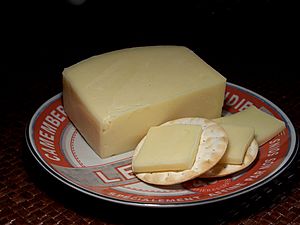Danbo facts for kids
Quick facts for kids Danbo |
|
|---|---|
 |
|
| Country of origin | Denmark |
| Source of milk | Cows |
| Texture | Semi-Soft |
| Fat content | 15-45% |
| Dimensions | rectangular |
| Weight | 6-9 kg |
| Aging time | 1.5-5 months |
Danbo is a yummy, semi-soft cheese that comes from Denmark. It is made from cow's milk. In 2017, Danbo cheese received a special award called "Protected Designation of Origin" (PDO). This means that only cheese made in a certain way and place in Denmark can be called Danbo. It's like a special label that protects its quality and origin.
This cheese usually ages for about 3 to 12 months. It comes in big rectangular blocks that weigh between 6 and 9 kilograms. During aging, the cheese is covered with a special kind of bacteria. This bacteria helps the cheese develop its unique flavor. When the cheese is ready, the bacteria is washed off. Then, the Danbo cheese is packaged and sent to stores for everyone to enjoy!
Contents
Different Kinds of Danbo Cheese
Danbo cheese is sold under a few different names. Each name often means a slightly different flavor or aging time.
Mild Danbo: Lillebror
One popular type is called Lillebror. This name means "little brother" in Danish. Lillebror is a very mild cheese. It's a great choice for children or people who prefer a softer cheese taste.
Strong Danbo: Gamle Ole
Another type is Gamle Ole, which means "Old Ole." This cheese is aged for a longer time. Because of this, it has a much stronger and sharper flavor. Some people might even find its smell quite strong! Traditionally, Gamle Ole is enjoyed on an open-faced sandwich. People often add slices of raw onion and a bit of meat jelly on top of the bread.
Danbo with Caraway Seeds
Sometimes, you might find Danbo cheese with Caraway seeds mixed in. These seeds add a traditional and unique flavor to the cheese. It's a popular way to enjoy Danbo in Denmark.
The History of Danbo Cheese
Danbo cheese has an interesting history, especially how it led to a new cheese in another country!
Danbo and Queijo Prato
In the early 1900s, some Danish people moved to Brazil. They settled in a place called Minas Gerais. These immigrants tried to make their traditional Danbo cheese using Brazilian milk. They discovered that the milk in Brazil made a slightly different, but still delicious, cheese. This new cheese became known as Queijo prato. So, Danbo cheese actually helped create a whole new type of cheese in Brazil!
See also
 In Spanish: Danbo para niños
In Spanish: Danbo para niños

